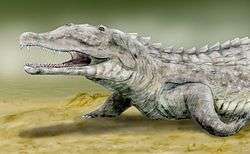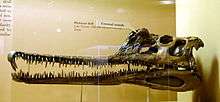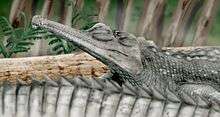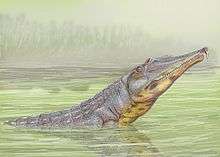Phytosaur
| Phytosaurs Temporal range: Carnian - Rhaetian, 228–199.6 Ma (possible Early Jurassic occurrence) | |
|---|---|
 | |
| Skull of Pseudopalatus mccauleyi | |
| Scientific classification | |
| Kingdom: | Animalia |
| Phylum: | Chordata |
| Class: | Reptilia |
| Clade: | Crurotarsi |
| Order: | Phytosauria von Meyer, 1861 |
| Family: | Phytosauridae Jaeger, 1828 |
| Genera | |
| Synonyms | |
|
Parasuchia Huxley, 1875 | |
Phytosaurs are an extinct group of large semi-aquatic Late Triassic archosauriform reptiles. Phytosaurs belong to the family Phytosauridae and the order Phytosauria. Phytosauria and Phytosauridae are often considered to be equivalent groupings containing the same species, but some studies have identified non-phytosaurid phytosaurians. Phytosaurs were long-snouted and heavily armoured, bearing a remarkable resemblance to modern crocodilians in size, appearance, and lifestyle, as an example of convergence or parallel evolution. The name "phytosaur" means "plant reptile", as the first fossils of phytosaurs were mistakenly thought to belong to plant eaters. The name is misleading because the sharp teeth in phytosaur jaws clearly show that they were predators.
For many years phytosaurs were considered to be the most basal group of crocodile-line archosaurs, meaning that they were thought to be more closely related to the crocodilians than to birds (the other living group of archosaurs). Recent studies of the evolutionary relationships of early archosauriforms suggest that phytosaurs evolved before the split between crocodile- and bird-line archosaurs and are the sister taxon of Archosauria.
Phytosaurs had a nearly global distribution during the Triassic. Fossils have been recovered from Europe, North America, India, Morocco, Thailand, Brazil, Greenland[1] and Madagascar. Fossils attributed to phytosaurs have been found in Early Jurassic rocks, possibly extending their temporal range beyond the Triassic-Jurassic boundary.
Description
Morphotypes

The phytosaur skull was characterized by three distinct morphotypes, which relate to feeding and habits and not (as was once thought) evolutionary relationships. These skull patterns are linked to characteristics of the dentition; specifically the differentiation or similarity of the teeth along the jaws.
Dolichorostral ("long snouted") types have a long, slender snout and a large number of conical teeth that are the same throughout. These were most likely piscivorous, able to capture fast slippery prey, but not so good at tackling a land animal. Some examples are Paleorhinus, Rutiodon carolinensis, and Mystriosuchus. At one time, it was believed that Paleorhinus and Mystriosuchus belonged to a distinct group of phytosaurs (subfamily of family Mystriosuchinae/Mystriosuchidae Huene, 1915) characterised by this adaptation, but it is now known that Mystriosuchus is actually more closely related to Pseudopalatus, an "altirostral" form (Hungerbühler, 2002).
Brachyrostral ("short snouted") forms are the opposite, they have a massive, broad snout, and a very strong skull and jaws, with the front teeth like fangs for holding the prey, and the rear teeth blade-like for slicing the meat into chunks that can easily be swallowed (an animal with different types of teeth like this is called heterodont). These were powerful animals specialised for feeding on strong struggling prey, such as terrestrial animals that came to the water to drink. Examples of this type are Nicrosaurus and Smilosuchus.
Altirostral ("high snouted") animals are intermediate between the two. They had heterodont dentition but not as extremely developed as the brachyrostral type. Angistorhinus and Pseudopalatus are typical examples here. These were most likely generalist feeders.
Modern crocodilians exhibit a similar morphological diversity, for example the broad snouted altirostral alligator and the long snouted dolichorostral gavial.
Phytosaurs were even better armoured than crocodiles, protected by heavy bony scutes (often found as fossils), and the belly reinforced with a dense arrangement of gastralia (abdominal ribs).
Differences from crocodiles
Despite their great similarities in appearance and lifestyle, there are still a number of minor differences that distinguish phytosaurs from true crocodiles. For one thing, the phytosaur ankle structure is much more primitive than that of any crocodile. Also, phytosaurs lack the bony secondary palate that enables crocodiles to breathe even when the mouth has much water. However, it is possible that phytosaurs had a fleshy palate, as many Mesozoic crocodiles are presumed to have had. Finally, and most noticeably, phytosaurs had nostrils placed near or above the level of the eyes, in contrast to crocodiles where the nostrils are near the end of the snout. This adaptation may have developed to allow them to breathe while the rest of the body was submerged.
Teeth
In a 2001 study of the biomechanics of the dinosaur Albertosaurus's teeth, William L. Abler also examined a phytosaur's teeth, finding that it had had serrations so fine that they resembled a crack in the tooth.[2] Albertosaurus had similarly crack-like serrations, but, at the base of each serration Abler discovered a round void, which would have functioned to distribute force over a larger surface area.[2] This void, termed an ampulla, would hinder the ability of the "crack" formed by the serration to propagate through the tooth.[2] The phytosaur was found to lack adaptations for preventing its dental "cracks" from propagating.[2] Abler examined another sort of prehistoric predator, Dimetrodon, and found that it lacked adaptations for guarding against crack propagation as well.[2]
Locomotion and terrestriality
Phytosaurs have been traditionally held as rather "primitive" animals in regards to terrestrial locomotion, particularly in regards to archosaurs such as crocodilians, lacking the erect gait seen in these, other pseudosuchians, dinosaurs and pterosaurs. However, the Apatopus ichnofossil shows that the animals did in fact have an erect gait like their archosaur relatives, raising the question of whether this trait evolved in the last common ancestor between phytosaurs and archosaurs or independently.[3][4]
Most phytosaurs are thought to be aquatic animals, and indeed most do show adaptations for such a lifestyle. However, at least Nicrosaurus seems to have evolved towards a secondarily terrestrial lifestyle, developing longer limb bones, straighter femura and a deeper pelvis, and indeed occurs in terrestrial or marginal lacustrine settings. Combined with its deep upper jaw, it probably led a similar lifestyle to terrestrial predatory crocodylomorphs like sebecians.[5]
History

When the first phytosaur fossils were found, it was not immediately obvious what kind of animal/species they were. The first phytosaur species known to science was named Phytosaurus cylindricodon - "plant lizard with cylindrical teeth" - by G. Jaeger in 1828 because he mistakenly believed that petrified mud fillings in the jaw were herbivore teeth. The specimen is too poor to be diagnostic, and this species name is no longer valid. The name of the group - Phytosauria - was coined by the German paleontologist Hermann von Meyer in 1861, on the basis of this first species.
The next species to be described was Belodon plieningeri by von Meyer in von Meyer and Plieninger 1844. The altogether more appropriate name Parasuchia ("alongside the crocodiles", as they resembled crocodiles to a great degree) was coined by Thomas Huxley in 1875 along with his discovery and naming of the Indian species Parasuchus hislopi (Chatterjee, 1978), on the basis of a partial snout. The specimen also is usually considered non-diagnostic, and the name Parasuchus replaced by Paleorhinus. Although the names Parasuchidae and Phytosauridae are variously still used by different specialists, "phytosaur" is the standard generic name for these animals, despite the fact that these animals have been clearly shown to be carnivorous.
Evolutionary history

Phytosaurs first appear during the Carnian age, evolving from an unknown crurotarsan ancestor. There are no clear intermediate forms, as even the earliest known phytosaurs are highly specialized aquatic animals, unlike most contemporary archosauriforms that were terrestrial.
The earliest phytosaurs belong to the widely distributed genus Paleorhinus. A somewhat more advanced and larger form, Angistorhinus appears at the same time or soon after. Later in the Carnian, both these animals were replaced by more specialised forms like Rutiodon, Leptosuchus, and the huge Smilosuchus (Lucas 1998). The Carnian-Norian extinction meant that these animals died off, and the Early Norian sees new genera like Nicrosaurus and Pseudopalatus, both of which belong to the most derived clade of phytosaurs, the Pseudopalatinae. Later in the middle Norian the advanced and specialised fish-eater Mystriosuchus appears. Fossil remains of this widespread animal is known from Germany, northern Italy, and Thailand. Finally the large Redondasaurus in south-west North America and the long-snouted (altirostral) Angistorhinopsis ruetimeyeri in Europe continued the group into the Rhaetian. Phytosaur footprints (the ichnotaxon Apatopus) are also known from the latest Rhaetian of the East Coast of USA (the Newark Supergroup) (Olsen et al. 2002). This indicates that phytosaurs continued as successful animals until the very end of the Triassic, when, along with many other large crurotarsan reptiles, they were killed off by the end Triassic extinction event.
There have been reports of phytosaur remains found in lowermost Jurassic rocks. Several teeth from Early Jurassic deposits in France have been identified as phytosaur teeth, but other studies argue they have either been misidentified or were reworked from Late Triassic into Early Jurassic deposits. In 1951, a partial upper jaw was discovered in the Early Jurassic Lower Lufeng Series in China and described as a new genus of phytosaur, Pachysuchus, but a study in 2012 reinterpreted the fossil as a sauropodomorph dinosaur.[6]
A fragment of a lower jaw from a longirostrine archosaur has been described from early Hettangian strata in the town of Watchet in Somerset, England. While teleosaurid thalattosuchians had similar longirostrine jaws to phytosaurs and were common in the Jurassic, they do not appear in earliest Jurassic rocks. The mandible is more similar to those of known phytosaurs than to thalattosuchians, and likely belongs to a phytosaur closely related to the genus Mystriosuchus. The presence of phytosaurs in the earliest Jurassic may have prevented thalattosuchians from occupying similar ecological niches at that time.[7] However, more recent work suggests that the jaw fragment came from a pre-Hettangian rock unit, and is therefore Late Triassic in age.[6]
Classification
Genera
| Genus | Status | Age | Location | Unit | Notes | Images |
|---|---|---|---|---|---|---|
| Junior synonym | Junior synonym of Nicrosaurus | |||||
| Valid | Late Carnian |  | ||||
| Valid | Middle Carnian | |||||
| Junior synonym | Junior synonym of Machaeroprosopus | |||||
| Nomen dubium | Middle Norian | Many remains have since been attributed to other animals or given their own genera |  | |||
| Valid | Carnian |
"Pre-Tecovas Horizon" (Dockum Group) |
||||
| Nomen dubium | Norian | Named from several teeth in 1856 | ||||
| Valid | Norian | |||||
| Valid | Late Carnian | |||||
| Nomen dubium | Late Carnian | |||||
| Valid | Carnian |
Tecovas Formation and unknown formation (Dockum Group) |
||||
| Valid | Carnian-Norian |  | ||||
| ? Valid | Triassic, ? early Olenekian | |||||
| Valid | Middle Norian | |||||
| Nicrosaurus | Valid | Late Norian - Rhaetian |
Arnstadt Formation |
 | ||
| Junior synonym | Late Carnian |
Hassberge Formation |
 | |||
| Valid | Late Carnian - Early Norian | |
||||
| Valid | Norian | |||||
| Valid | ||||||
| Valid | Norian |  | ||||
| Junior synonym | Junior synonym of Machaeroprosopus | |||||
| Valid | Norian - Rhaetian | | ||||
| Valid | Carnian |  | ||||
| Valid | Carnian | | ||||
Phylogeny
Phytosaurs are generally regarded as the most basal group of Crurotarsi, a clade of archosaurs that includes crocodilians and their extinct relatives.[8][9][10] Phytosaurs are often excluded from a clade called Suchia, which usually encompasses all other crurotarsans, including aetosaurs, rauisuchians, and crocodylomorphs.[10] Some studies have found polytomies between phytosaurs and other groups, like Ornithosuchidae and Suchia. In these cases, it is unclear whether phytosaurs are the most basal crurotarsans.[11] In one of the earliest studies of crurotarsan phylogeny, Sereno and Arcucci (1990) found Crurotarsi to be a monophyletic grouping consisting of phytosaurs, ornithosuchids, and the more derived suchians, but produced a trichotomy between the three groups in their tree.[12] In resolving this trichotomy, Parrish (1993) placed ornithosuchids, not phytosaurs, as the most basal crurotarsans. However, most other studies such as Sereno (1991) and Benton et al. (2010) recover phytosaurs in a basalmost position among crurotarsans.[13] Below is a cladogram modified from Benton et al. (2010) showing the widely accepted phylogenetic relationships of phytosaurs:[10]
| Archosauria |
| ||||||||||||||||||||||||||||||
| |
A phylogenetic analysis of early archosaurs by Nesbitt (2011) found strong support for a sister taxon relationship between phytosaurs and Archosauria.[14] If this is the case, phytosaurs would be placed outside Pseudosuchia in a more basal position among archosauriforms. Phytosaurs would be considered closely related to the ancestors of both crocodilians and dinosaurs. Furthermore, the definition of the clade Crurotarsi would change, as it is often defined by the inclusion of phytosaurs. Thus, Crurotarsi would include phytosaurs and all other archosaurs —including dinosaurs— under this phylogeny.[15] Below is a cladogram showing the placement of phytosaurs from Nesbitt (2011):[14]
| Archosauriformes |
| ||||||||||||||||||||||||||||||||||||||||||||||||||||||||||||
| |
The phylogenetic analysis of Stocker (2010) placed Paleorhinus outside Phytosauridae as a basal phytosaur. Under this phylogeny, Phytosauridae and Phytosauria are not synonymous. Stocker also erected the clade Leptosuchomorpha for derived phytosaurs, including Leptosuchus and Smilosuchus.[16]
Footnotes
- ↑ Mateus, O., Clemmensen L., Klein N., Wings O., Frobøse N., Milàn J., Adolfssen J., & Estrup E. (2014). The Late Triassic of Jameson Land revisited: new vertebrate findings and the first phytosaur from Greenland. Journal of Vertebrate Paleontology. Program and Abstracts, 2014, 182.
- 1 2 3 4 5 "Abstract," Abler (2001). Page 84.
- ↑ Padian, K., Li, C., & Pchelnikova, J. 2010. The trackmaker of (Late Triassic, North America): implications for the evolution of archosaur stance and gait. Palaeontology 53, 175-189.
- ↑ Klein, H. & Lucas, S. G. 2013. The Late Triassic tetrapod ichnotaxon Apatopus lineatus (Bock, 1952) and its distribution. Bulletin of the New Mexico Museum of Natural History 61, 313-324.
- ↑ Kimmig, J. 2013. Possible secondarily terrestrial lifestyle in the European phytosaur Nicrosaurus kapfii (Late Triassic, Norian): a preliminary study. Bulletin of the New Mexico Museum of Natural History and Science 61, 306-312.
- 1 2 Paul M. Barrett and Xu Xing (2012). "The enigmatic reptile Pachysuchus imperfectus Young, 1951 from the Lower Lufeng Formation (Lower Jurassic) of Yunnan, China" (PDF). Vertebrata PalAsiatica. 50 (2): 151–159.
- ↑ Maisch and Kapitzke (2010).
- ↑ Benton, M.J. (1999). "Scleromochlus taylori and the origin of dinosaurs and pterosaurs" (PDF). Philosophical Transactions of the Royal Society B: Biological Sciences. 354: 1423–1446. doi:10.1098/rstb.1999.0489.
- ↑ Nesbitt, S.J. (2007). "The anatomy of Effigia okeeffeae (Archosauria, Suchia), theropod-like convergence, and the distribution of related taxa" (PDF). Bulletin of the American Museum of Natural History. 302: 1–84. doi:10.1206/0003-0090(2007)302[1:TAOEOA]2.0.CO;2.
- 1 2 3 Brusatte, S.L.; Benton, M.J.; Desojo, J.B.; Langer, M.C. (2010). "The higher-level phylogeny of Archosauria (Tetrapoda: Diapsida)". Journal of Systematic Palaeontology. 8 (1): 3–47. doi:10.1080/14772010903537732.
- ↑ Gower, D.J.; Wilkinson, M. (1996). "Is there any consensus on basal archosaur phylogeny?". Proceedings of the Royal Society B: Biological Sciences. 263 (1375): 1399–1406. doi:10.1098/rspb.1996.0205.
- ↑ Sereno, P.C.; Arcucci, A.B. (1990). "The monophyly of crurotarsal archosaurs and the origin of bird and crocodile ankle joints". Neues Jahrbuch für Geologie und Paläontologie, Abhandlungen. 180: 21–52.
- ↑ Sereno, P.C. (1991). "Basal archosaurs: phylogenetic relationships and functional implications". Journal of Vertebrate Paleontology. 11 (4, Supplement): 1–53. doi:10.1080/02724634.1991.10011426.
- 1 2 Nesbitt, S.J. (2011). "The early evolution of archosaurs: relationships and the origin of major clades" (PDF). Bulletin of the American Museum of Natural History. 352: 1–292. doi:10.1206/352.1.
- ↑ Parker, Bill (27 April 2011). "Dinosaurs Are Crurotarsans". Chinleana. Blogger. Retrieved 27 April 2011.
- ↑ Michelle R. Stocker (2010). "A new taxon of phytosaur (Archosauria: Pseudosuchia) from the Late Triassic (Norian) Sonsela Member (Chinle Formation) in Arizona, and a critical reevaluation of Leptosuchus Case, 1922". Palaeontology. 53 (5): 997–1022. doi:10.1111/j.1475-4983.2010.00983.x.
Sources
- Abler, W.L. 2001. A kerf-and-drill model of tyrannosaur tooth serrations. p. 84-89. In: Mesozoic Vertebrate Life. Ed.s Tanke, D. H., Carpenter, K., Skrepnick, M. W. Indiana University Press.
- Carroll, R.L. (1988). Vertebrate Paleontology and Evolution, WH Freeman & Co.
- Chatterjee, S. (1978). A primitive parasuchid (phytosaur) reptile from the Upper Triassic Maleri Formation of India, Palaeontology 21: 83-127
- Hungerbühler, A. (2002). The Late Triassic phytosaur Mystriosuchus Westphali, with a revision of the genus. Palaeontology 45 (2): 377-418
- Jaeger, G.F. 1828. Über die fossilen Reptilien, welche in Würtemberg aufgefunden worden sind. Metzler, Stuttgart.
- Kimmig, J. & Arp, G. (2010) Phytosaur remains from the Norian Arnstadt Formation (Leine Valley, Germany), with reference to European phytosaur habitats. Palaeodiversity 3: 215-224
- Lucas, S.G. (1998). Global Triassic tetrapod biostratigraphy and biochronology. Paleogeog. Palaeoclimatol., Palaeoecol. 143: 347-384.
- Maisch, M.W.; Kapitzke, M. (2010). "A presumably marine phytosaur (Reptilia: Archosauria) from the pre-planorbis beds (Hettangian) of England". Neues Jahrbuch für Geologie und Paläontologie - Abhandlungen. 257 (3): 373–379. doi:10.1127/0077-7749/2010/0076.
- Olsen, P.E., Kent, D.V., H.-D.Sues, Koeberl, C., Huber, H., Montanari, E.C.Rainforth, A., Fowell, S.J., Szajna, M.J., and Hartline, B.W., (2002). Ascent of dinosaurs linked to an iridium anomaly at the Triassic-Jurassic boundary. Science 296: 1305-1307.
- Stocker, Michelle R. (2010). "A new taxon of phytosaur (Archosauria: Pseudosuchia) from the Late Triassic (Norian) Sonsela Member (Chinle Formation) in Arizona, and a critical reevaluation of Leptosuchus, Case, 1922". Palaeontology. 53 (5): 997–1022. doi:10.1111/j.1475-4983.2010.00983.x.
- Ballew, K.L. (1989). A phylogenetic analysis of Phytosauria from the Late Triassic of the Western United States. Dawn of the age of dinosaurs in the American Southwest: pp. 309–339.
- Gregory, J.T. (1962). Genera of phytosaurs. American Journal of Science, 260: 652-690.
- Long, R.A. & Murry, P.A. (1995). Late Triassic (Carnian and Norian) tetrapods from the southwestern United States. New Mexico Museum of Natural History and Science Bulletin, 4: 1-254.
External links
- Translation and Pronunciation Guide
- A Preliminary Biomechanical Analysis of Phytosaur Life Habits
- Phytosauria - Palaeos
- Mikko's Phylogeny - cladistic tree
- Great Triassic Assemblages Pt 1 - The Chinle and Newark - some material on phytosaurs
| Wikimedia Commons has media related to Phytosauria. |
